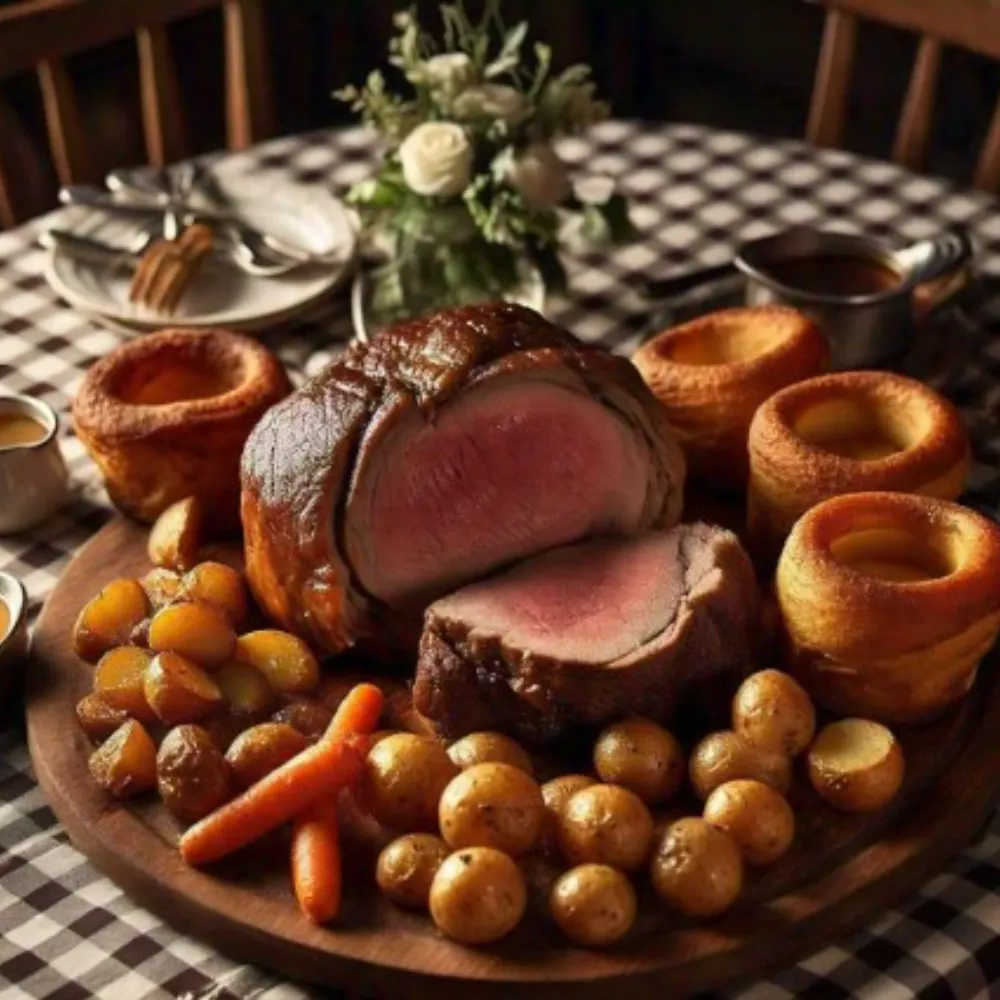Easy Roast Beef and Yorkshire Pudding Recipe
For your next Sunday roast, twist the classic meal and enjoy the delicious roast beef and Yorkshire pudding. This traditional English recipe will allow you to cook juicy meat and enjoy tender, crispy puddings your family and dinner guests will love.
This favorite combination might sound tricky, but actually, mastering this keyboard shortcut is as easy as pie! Combined with proper cooking methods and some basic cooking, you can cook restaurant-like meals in the comfort of your own home.
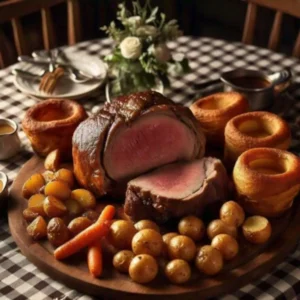
It certainly is, which is why you should go on reading this to learn how you can prepare this timeless favorite to perfection. I have 20 years of experience in cooking. So you can trust me.
The Ultimate Guide to Roast Beef and Yorkshire Pudding for First-Timers
Selecting the Perfect Cut
So, before starting to explore the world of roast beef and Yorkshire pudding, the question of the right cut becomes vital. Newcomers should use a top round roast or sirloin tip roast to prepare their meals. These cuts are tender, tasty, and much less tricky to prepare for those who have limited experience in cooking.
Selection criteria also include finding a piece with some marble, as this makes the finished product more juicy and tasty.
Mastering the Roast
To achieve that coveted crispy exterior and tender, pink interior, follow these key steps:
- Let your roast come to room temperature before cooking it.
- Season with salt and pepper, or whatever else you prefer to put on your food; it is very important.
- Reverse brown with a sear to grill before finishing in an oven.
- Need help with the gravy, please; it was a bit lumpy when I inserted the meat thermometer; it read 135°F (57°C).
- Let it stand for about 15-20 minutes before carving it.
Perfecting Yorkshire Pudding
The quintessential accompaniment to roast beef, Yorkshire pudding, can seem daunting but is surprisingly simple with these tips:
- That means you put as many eggs as you put milk and flour when preparing the batter.
- Allow the batter to stand at room temperature for not less than 30 minutes before baking.
- They recommend that oil or beef drippings be heated until smoking on the pan before placing the steak on it.
- For that to rise and crisp in the batter, pour it over the hot oil.
Timing Is Everything
Coordinating the roast and puddings can be tricky, but here’s a pro tip: begin your roast initially, and while the latter is standing, heat the oven and make your Yorkshire puddings. This way both components are served at their best conditions.
Serving Suggestions
Your British-inspired meal can be filled with traditional accompaniments such as roasted potatoes and honey-glazed carrots, as well as beef-dripping gravy. And if you’d like to give it a bit of spice, don’t forget the horseradish sauce too.
Through this guide, even novices in the kitchen can prepare a roast beef and Yorkshire pudding dinner for their family that would easily put to shame any Sunday roast in England. The more you prepare it, you will gradually start preparing this British classic dish for friends and/or family members.
5 Common Mistakes to Avoid When Making Yorkshire Pudding
A favorite dinner in the UK, Yorkshire pudding, can make your roast dinner just a little better. But it is not possible to achieve the ideal rise and crispy many times. Here’s a look at 5 mistakes you should steer clear of when preparing this much-lauded accompaniment.
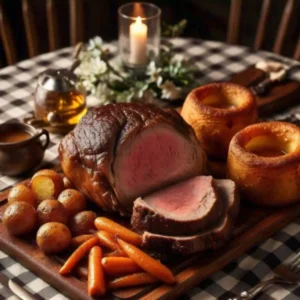
Using the Wrong Fat
The fat used is one of the most important factors that must be carefully chosen to get the best Yorkshire pudding. While the modern versions of some recipes use vegetable oil, purists prefer beef drippings.
The thing is to employ a fat with a high smoke point that can handle the high temperatures necessary for that optimal rise. You shouldn’t use butter or low-smoke point oils because they are likely to burn and give your puddings a bad taste.
Skipping the Resting Period
After whisking your batter, use this method; it is sometimes so satisfying just to pour it directly into the tin and bake it. Nonetheless, such a fast pace of life often disappoints. Letting your batter sit for at least half an hour (or even better, leave it sitting in the refrigerator overnight) makes the flour properly soak up the liquid.
This reduction of the gluten formation period leads to the formation of smooth batter and better easement and formation of batter texture.
Not Preheating the Pan
Another mistake that may cause disappointment for Yorkshire pudding is not preheating the pan. To get that perfect round rise and the crunch on the outside of the nugget, your pan and oil must be hot when you are putting the batter in.
Make sure you warm your pan in the oven for at least 10 minutes so that the oil will be made. This makes sure that the batter responds instantly when it is poured into the hot oil, hence resulting in that well-desired rise.
Overheating the Batter
As the rule goes, you should fold in your ingredients quite vigorously, but avoid overmixing your batter or your puddings will be tough and chewy. It should be a smooth batter consistency with no lumps but do not overmix the batter.
Because of this, an overdeveloped batter will have too much gluten formation, leading to a tough and dense texture instead of the open, airy structure of the perfect batter. You need to mix just enough so that all is incorporated and then wait.
Opening the Oven Door Too Soon
It is always important to be patient while preparing Yorkshire puddings, for example. When the door to the oven is opened during the required baking period, there is an abrupt change of temperature, and hence flat pudding.
Avoid opening the oven door for the first 20 minutes of baking at best. This enables the puddings to set both their structure and their color to be that gorgeous golden brown. After they have risen and set, you can check on them; however, these should be done fast so as not to tamper with the oven’s temperature.
By ensuring you have steered clear of these common mistakes, then you are on your way to making the perfect Yorkshire puddings that are crispy on the outer side, light and soft on the inner side, and a crowd-pleaser. The best way is to practice, practice, and practice, so relax if you did not do it perfectly the first time. This is an essential British dish, and with time and experience, you will master it.
Roast Beef Simplified: Best Cuts, Cooking Times, and Seasoning Tips
Selecting the Perfect Cut
Even when it comes to roast beef, presenting the proper cut is very crucial. To have their meat tender and juicy, it is recommended to choose cuts from the rib or loins. Prime rib, ribeye roast, and tenderloin are some of the best-eating meat pieces that should rarely be consumed along with daily meals.
Penny-wise cuts include the top round, bottom round, and sirloin tip ania, top round, or bottom round. These cuts may take longer to cook but should be cooked well, as the following photos show they can be delicious.
Mastering Cooking Times
There is, however, nothing as important as cooking times and temperature if you are to produce a well-done roast beef. The general guideline you can follow is to roast beef at 375°F for about 20 minutes per pound to have medium-rare beef.
However, it is advisable to follow the instructions in the letter and use a meat thermometer. Medium-rare should have an internal temperature of 135°F (57°C). As for the roast, it is important to let the cooked product stay on a tray to reabsorb juices and slightly increase the temperature for 10-15 minutes.
Seasoning Secrets
Raising the stakes on your roast beef; seasoning tips. Base your seasoning and mary out with salt and freshly ground black pepper on a thick layer. To enhance the depth of flavor, you could use rosemary, thyme, and garlic to make an herb rub.
Secondly, a mustard and herb crust is likely to bring tanginess to the preparation. Ideally, marinate your roast at least an hour before cooking because the longer the seasonings are in contact with the roast, the better the roast absorbs the flavor.
Cooking Methods for Success
However, do not ignore other methods of cooking; oven-roasting is the most conventional, but there are others. By preheating the oven at a low temperature and followed by high heat searing, foods can be cooked through with a striking crust on the outside.
For stake-like items, opt for slow cookery to achieve pull-apart texture. Regardless of what you choose, let your roast reach the counter before cooking to have a uniform heat all through cooking.
If you want to cook juicy roast beef and your dinner party food to be the best, you need to understand how to choose your cuts and what temperatures and times they can be cooked and seasoned under.
Yorkshire Pudding 101: The Science Behind the Puff
If Yorkshire pudding is a food or, more controversially, a science experiment, then it’s one of the best-loved in Britain. To get that perfect, flawless halo of smoke.
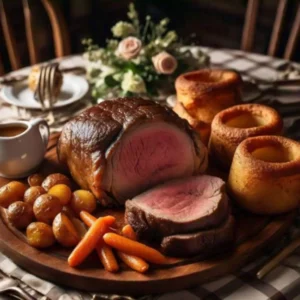
The Magic of Gluten and Steam
And at the center of Yorkshire Pudding’s rags-to-fame story is gluten and steam. As you try to combine flour with liquid, the glutenin proteins, which are found in the grain, align themselves and form long, elastic-like structures. These chains prevent the steam from the liquid ingredients as the batter bakes in the oven and the pudding rises tremendously.
To achieve the greatest effect, there is only one crucial element that needs to be wisely used, and that is the temperature. Putting cold batter directly in a hot pan creates a reaction immediately. The outside of the product sets quickly, while the center of the product remains in a plastic state.
When heated, the enclosed moisture evaporates and exerts pressure on the semi-rigid, forcing the pudding to expand or rise and at the same time making a hollow center.
The Role of Fat and Heat
One of the primary ingredients in achieving that sought-after, blissful puff is high-heat cooking oil. Originally beef dripping but should be any oil suitable to be used for deep frying at approximately a high smoke point. It is also important to preheat the oil in the pan, as it gives that first sound when the batter initially touches and prepares a crust layer for the pudding to stand on before it rises.
Temperature in an oven also has lots of contribution to the loaf that is truly essential. A hot oven (approximately 425°F or 220°C) is needed in order to achieve a very sharp temperature change, which should make the pudding rise. It also brings a high heat, which makes Yorkshire pudding attain the required golden brown color and crispy structure, which is widely preferred by most consumers.
Perfecting Your Technique
To achieve consistent results, consider these scientific tips:
- Let the batter rest: This makes it easier for the more relaxed gluten to expand, thereby making bread softer.
- Use room-temperature eggs: They incorporate other battering materials more evenly, hence resulting in a more refined batter.
- Don’t open the oven door: Fluctuations in temperature are likely to result in your puddings falling flat.
Learning these scientific principles will take your Yorkshire pudding game from your simple culinary techniques to an art form. The next time you mix a batch, remember that you are not baking by following a set of instructions, but you are performing a culinary, physics, and chemistry experiment.
How to Create a Complete Roast Dinner: From Meat to Pudding
Mastering ways of cooking a perfect roast dinner has been taken as a science that needs technique, time, and tradition. As simple as choosing the right cut of beef to make the famous Yorkshire pudding, all these serve a purpose in making the meal.
Now without much ado, I bring you the basics of making a perfect Sunday roast, which is very popular in Britain.
Selecting and Preparing the Roast Beef
Well, needless to say, the joint of meat that takes the floral place in the middle of the table is usually beef. For the best outcome, choose a quality cut of the meat, like, for example, the ribeye, sirloin, or top round.
Preheat the meat to room temperature and sprinkle it with salt and black pepper before preparing the meal. A roast should bake in a 375-degree Fahrenheit or 190-degree Celsius oven if one wants a medium-rare roast. Cooking time by weight is usually 20 minutes per pound plus 20 minutes of resting time.
Mastering Yorkshire Pudding
Every mustard-fed beef roast must always be accompanied by Yorkshire pudding. This delicious vegetable preparation can only be made from eggs, flour, and milk batter. The secret to that perfect rise involves hot oil and a preheated pan.
Pour this batter into hot oil and see it rise to form a golden and crispy cake right before your eyes. To make the batter, you can even prepare it several hours before and keep it in the refrigerator for about half an hour to an hour before baking.
Coordinating Side Dishes
While the beef roasts and the puddings are rising, make preparations for the side dishes that accompany the meal. Roast potatoes, carrots, or parsnips might go well with it. First, boil the potatoes for additional crispness when roasted with the vegetables in the same oven as the beef. Do not omit the gravy; this should be made from the meat drippings and add the final accessory to the meal.
Timing and Presentation
Timing is very important when preparing a roast dinner. Begin with the beef; while it is cooking, you can make the sides at the same time. Yorkshire puddings should be the last thing to be put into the oven, always to be served hot.
While the beef is being curated, make sure to cook your vegetables and also gravy. Slice the meat across the grain and serve everything on eaten plates to complete the restaurant’s perfect look.
Equipment Essentials: Tools You Need for Roast Beef and Yorkshire Pudding
There is more to cooking the most awesome roast beef and Yorkshire pudding than good ingredients alone. The right tools go a long way as far as preparing some tastier, restaurant-like dish is concerned. Let’s take a closer look at what you will have to learn to cook this perfect British meal perfectly.
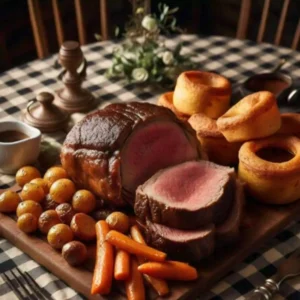
Roasting Pan and Rack
A heavy-bottomed roasting pan is most important for even heating and forming those delectable pan drippings. Choose a deep pan to reduce splatter and save yourself the sweat of scrubbing a sticky pan for hours.
To achieve an optimum level of browning, beef is placed on a rack that can be pulled out to facilitate heat circulation and the crispiness of the outside part.
Meat Thermometer
When it comes to making a perfect roast beef, you always need a good meat thermometer on your side. A digital ThermoProbe thermometer reveals the temperatures without delay, making it easier to determine the level of doneness without any uncertainties.
Yorkshire Pudding Tins
Original Yorkshire puddings need trays with round and deep wells for cooking. This type of tin, usually made of metal, aids in the establishment of the crisp tin outer surface and the soft puffy inner surface.
If you don’t have Yorkshire pudding tins at your disposal, you can make use of a basic 12-cup muffin tin.
Mixing Bowl and Whisk
To make the batter for Yorkshire pudding, one requires a big mixing bowl and a heavy type of whisk. Try and find a bowl that has a pouring lip to make the process of filling the tins easier and less spillage.
Using a balloon whisk ensures that you are driving air into the batter, thus creating great, free-flowing puddings.
Carving Set
For your roast beef to impress your guests, please ensure you use a good carving knife and fork. A fine carving knife and a good fork will facilitate the carving of the meat into even thin slices to retain as much juice as well as the good looks of the dish.
Basting Brush and Spoon
A great silicone basting brush and a large spoon are used to bake the roast using the juices generated during cooking. This helps in the retention of moisture on the meat and, at the same time, seasoning the outside.
Having the following tools in your kitchen will ensure you prepare a special roast beef and Yorkshire pudding feast. Do not forget that having good-quality equipment will also improve your cooking experience and the overall quality of your food.
Perfect Pairings: Best Sauces and Sides for Roast Beef and Yorkshire Pudding
Classic Sauces to Elevate Your Roast
When it comes to roast beef and Yorkshire pudding, the right sauce can make or break the meal. Interesting side dishes can be considered to improve whatever dish you are serving and turn it into a mouthwatering delicacy.
In addition to gravy, which can be made from the beef’s pan drippings, for a more conventional side dish, you might prepare. This gravy makes a rich accompaniment to both the meat and pudding, to the best of my knowledge.
On the other hand, a horseradish sauce has a sharp sting that counters the heavy texture of the beef. In addition to being tender, a rich mustard sauce makes the learners happy, and they enjoy eating the meat with gusto for the sharp taste it brings.
Vegetable Sides for a Well-Rounded Meal
For the appetite-hungry main meal, enjoy your roast beef and Yorkshire pudding with some bright vegetarian dishes. Carrots, parsnips, and potatoes are examples of root vegetables that, when roasted, are colorful, have an earthy feel to them, and have a texture that co-lays on beef.
For the green touch, you could have broccoli, which you steam, or bright green Brussels sprouts sautéed in garlic butter. These vegetables belong to the family of cruciferous and add a great texture and nutrients to your meal.
Unexpected Twists on Traditional Sides
Some general rules apply, but it is useful to remember that it is safe to stick to the classic, but it is also worth trying something new here. A tart fennel and apple as a side dish will complement the affluence of the food to bring a balance in taste.
If you prefer something richer, you would like creamy cauliflower cheese perfect for those who fancy meat, as it is velvety and rather savory. Another happy marriage is between the roasted butternut squash and sage, which gives it just the perfect sweet note.
Wine Pairings to Complete the Experience
When craving the juicy roast beef and fluffy Yorkshire pudding dinner, you cannot go wrong when you drink it with the right wine. A big red wine like Cabernet Sauvignon or Malbec will complement the beef flavors because it will not be overpowering.
These tannins counter the fattiness of the food being served, and the fruity flavors complement the meal. For those who love white wine, a Chardonnay will work perfectly well. Bear in mind that when preparing the dish sides or sauce that you intend to pair the wine with.
Conclusion
I hope this article helps to show that making a traditional roast beef dinner with Yorkshire pudding is not nearly as difficult as it may seem. If you just insist on these clear instructions and simple advice, you will be able to cook a British dinner that will satisfy your family and dinner invitees as being homely as well as fancy.
Do not forget that when you are preparing a recipe, make sure that you use the best quality produce; observe the right cooking temperatures and timing of the components properly. In a short while, you can become an expert at Sunday roasts and make a special dining moment out of it.
Put on your cooking attire, turn on your stove and oven, and get ready for the taste and mouthfeel of this classic favorite.
Frequently Asked Questions
How long should I cook the roast beef?
The cooking time of roast beef depends on the weight of the beef and the desired tenderness. By and large, grill the beef for half an hour per pound if you prefer medium-rare. However, to avoid any possibility of this measure not achieving the required effect, it is necessary to use a meat thermometer.
For medium-rare, the temperature has to be 135°F or 57°C. After placing your perfect roast in the oven, ensure you remove it from the oven after some time and allow it to cool for about 10-15 minutes since the temperature of the meat will increase slightly as it cools.
Can I make Yorkshire pudding ahead of time?
Although Yorkshire pudding should be consumed immediately and still hot, the batter may be prepared beforehand. Chop the ingredients and combine them; the batter should be cool and can be left to chill in the refrigerator for about 12 hours before baking.
It is the sting period that can enhance the texture of your puddings so much. Once ready to fry, let the batter get to room temperature, and with a quick stir, pour the batter into hot oil in the tins.
What’s the secret to crispy Yorkshire puddings?
The key to achieving crispy, well-risen Yorkshire puddings lies in two factors: a hot oven and preheated oil. Most recipes recommend a temperature of 425°F (220°C) for the oven and place a little oil in each cup of a muffin.
Put the tin into the oven for approximately ten minutes and until the oil is smoking. Then quickly pour the batter in the tin and put it back into the oven as soon as you can. The hot oil also makes the steam work up so that the puddings rise and get crunchy outside.
Can I use a different cut of beef for this recipe?
There are several ways of roasting it. By preparing it with beef ribeye or beef tenderloin, commonly known as sirloin, you can prepare it for any cut. Round steak, top round steak, bottom round steak, and the ear or eye of a round steak are cheap steaks to go for.
To indulge oneself, the best recommendation is that of the prime rib. In any case, the duration will vary depending on the meat’s thickness and the degree of its readiness; the recommended thing is to use the temperature indicators specifically for the meat.
About Us:
Rooted in Tradition: Unique Thanksgiving Side Recipes
The Complete Guide to Kimchi Making for Beginners
Easy Roast Beef and Yorkshire Pudding Recipe

Hello! My name is Wahab Khan. I, having over 20 years of culinary experience, bring both my knowledge and passion to each Recipe featured here. I create delicious, accessible dishes for beginners and seasoned cooks alike, and think that good food can help connect people. My recipes combine timeless techniques with stellar new spins, allowing readers to master the everyday flavors of the World.
